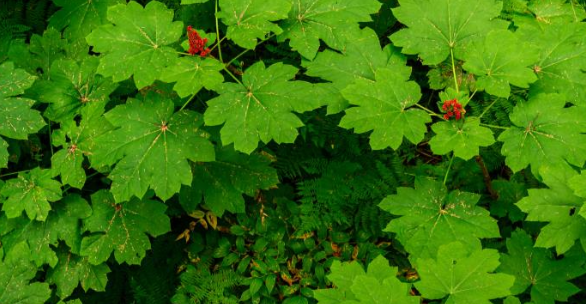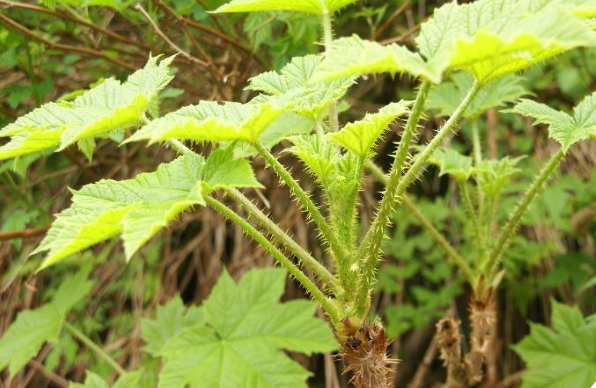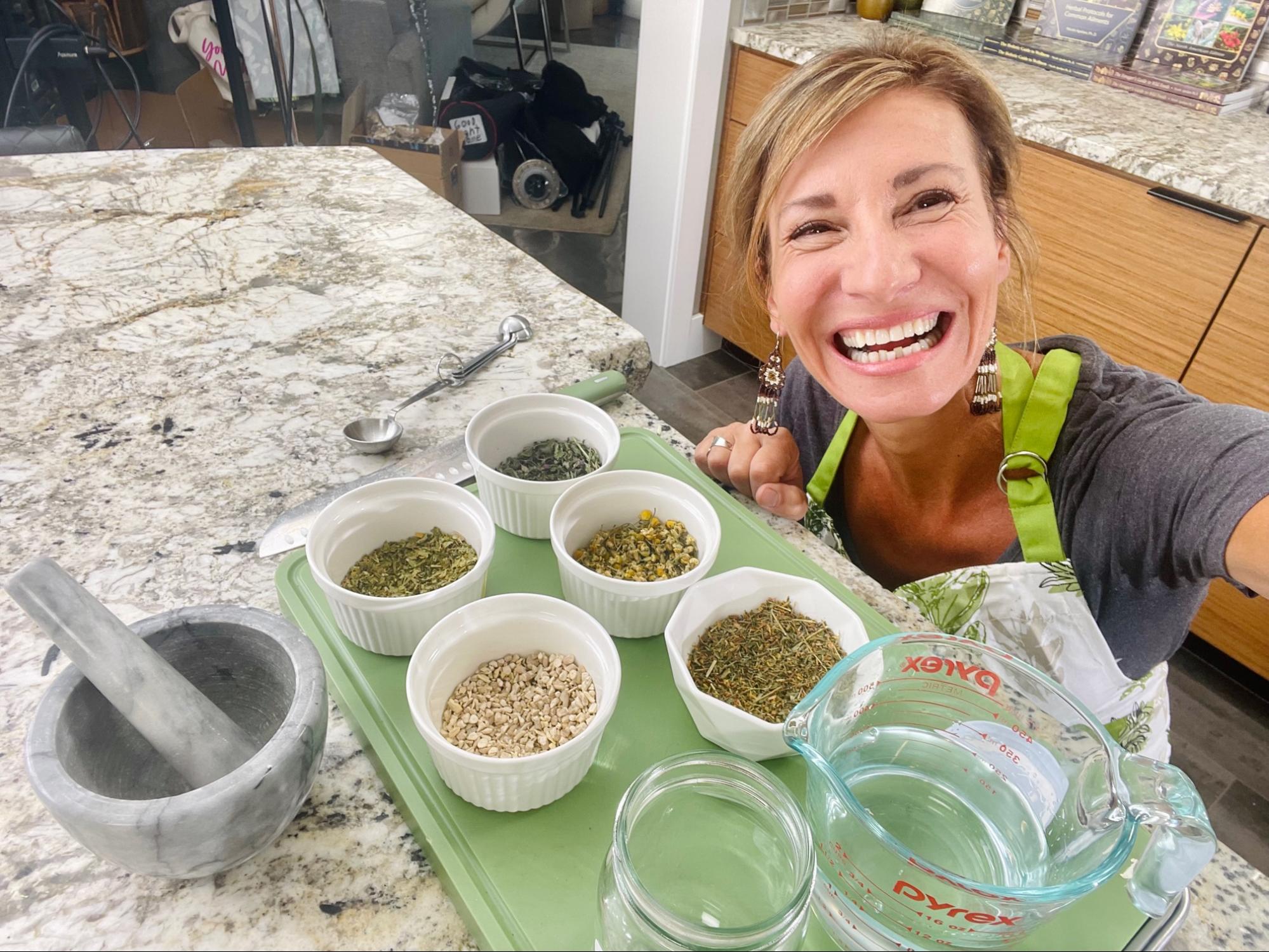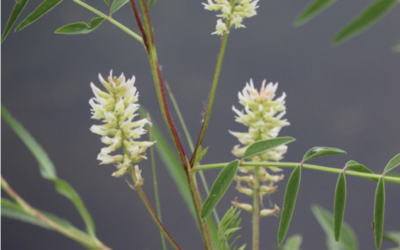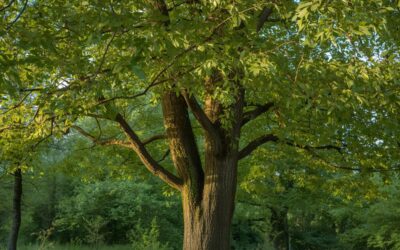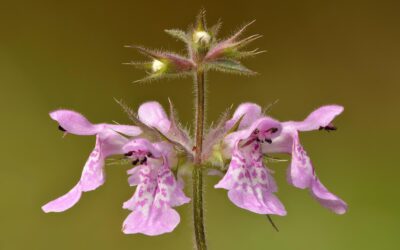Nature’s “Cure-All” Plant
A relative of American ginseng, Devil’s Club is often called “Alaskan ginseng”. While there are similarities, Devil’s Club is not a true ginseng in the Panax genus, but rather in the Araliaceae family. There are many uses for the botanical — it’s considered a valuable adaptogen that also relieves pain, calms inflammation, purifies the blood, treats infections, and more. Because of this, it’s often referred to as a “cure-all” plant. As the fame and usefulness of the plant become more well-known, it is also endangering its survival. Always use best practices for harvesting, which I will cover below.
Basic Identification
With large leaves, woody stems, and substantial spines, devil’s club is difficult to miss. A slow-growing plant, it typically reaches up to 5 feet (1.5m) tall, but can grow up to 15 feet (4.5m) in height. Leaves are palmate and spirally arranged with 5 to 15 lobes that measure 8 to 16 inches (20cm to 40 cm) across. The small flowers are green-white and grow in dense umbels 4 to 8 inches (10-20 cm) in diameter. The ripe fruit is a small red drupe about 1/4 inch (0.75 cm) wide.
Where Does It Grow? Devil’s Club thrives in the damp woodlands of North America’s Pacific Northwest.
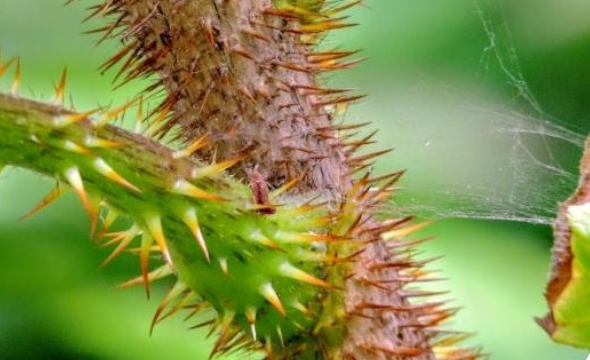
Harvesting and Safety
As the medicinal uses of Devil’s Club have become more popular, the plant has become increasingly over-harvested despite its pronounced, irritating spines. Please harvest only what you need. Wear heavy leather gloves and protective clothing while handling. For medicinal purposes, harvest the inner bark of the root and stems that are found along the ground and have lost their spines. Dig around the roots to expose and cut any small roots holding the plant in place. Pull up the root. Since Devil’s Club tends to be over-harvested, it’s important to re-plant the cut end of any stalks that you have removed from the plant back into the soil. They will grow roots and ensure another harvest next year. The berries are poisonous to humans; make sure to leave them to encourage propagation. Because of the hormonal effects of the plant, women in their first trimester should not harvest or use this plant.
Edible Uses
For only a few days in the spring, the very young shoots are delicious when cooked. When the leaf buds break through their sheath and are between 1 to 2 inches (2.5 cm to 5 cm) long, the leaf spines are soft and edible — but they quickly harden, rendering the shoot inedible. The berries are poisonous.
Recipe. Devil’s Club Decoction. You’ll need 4 tablespoons of Devil’s Club root bark and 2 cups of spring water. Chop or grind the root bark into very small pieces. Mix with the spring water and bring to a boil. Reduce the heat and simmer for 20 to 40 minutes. Cool. This is a strong decoction for external use or take internally in small doses as needed.
Here are my top 3 medicinal uses for Devil’s Club:
Adaptogenic “Cure-All”: The inner bark and stems can be used medicinally for a wide range of ailments — including as a pain-reliever, anti-inflammatory, blood purifier, and blood sugar regulator. Devil’s club also helps to alleviate adrenal fatigue and helps treat infections. For a convenient blood sugar control alternative, see our Heart Health Blend in the apothecary.
Coughs, Colds, Bronchitis, and Tuberculosis: An infusion of the inner bark and stems addresses respiratory complaints by calming excess mucous and eliminating toxins. A decoction can be used for tuberculosis. Have a look at our Bronchial Blend if you are seeking a ready-made extract for respiratory health.
Hormone Regulation and Cancer: Devil’s Club demonstrates anti-cancer action and helps regulate hormone levels. There are many new studies in this area of application.
But that’s just the beginning. In The Lost Book of Herbal Remedies: The Healing Power of Plant Medicine, I share over 16 traditional uses for Devil’s Club and many other medicinal herbs — as well as sustainable harvesting advice and simple instructions for making DIY remedies at home. Tap HERE to learn more!
Dive Deeper Into Herbal Medicine With My Online Herbal Academy
If you would like to deepen your knowledge of herbal medicine with hands-on instruction, my online Herbal Academy Master Course is for you!
You will learn how to make dozens of different extractions, salves, poultices, tinctures, syrups, oil infusions, and more.
Once you have signed up for the course, you will receive The Lost Remedies Academy Guidebook that contains all the information from the videos for swiftly identifying plants with clear pictures and diagrams. As a bonus, I’m including three additional digital resources for anti-inflammatory meal plans, wild edibles found around your home, and an herbal weight loss protocol with 50+ recipes.
Unlock the secrets of nature with a one-time purchase that grants you and your family instant lifetime access to my in-depth Lost Remedies Academy. Say goodbye to subscriptions and enjoy a world of knowledge anytime, anywhere on your phone, tablet, laptop, or TV. I am so confident in the value of my academy that I offer a 60-day, no-questions-asked money-back guarantee.
Whether you’re a beginner eager to explore the world of medicinal herbs and foraging, or you’re looking to expand existing knowledge, this course is tailored to empower you to take charge of your health and self-sufficiency, while reducing the need for costly medical visits.
I know you are going to love it! Tap HERE and join today!
Nicole Apelian

